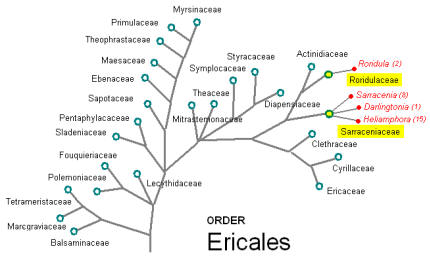Classification
Domain – Eukarya
Kingdom – Plantae
Division – Magnoliophyta
Class – Magnoliopsida
Order – Ericales
Family – Lecythidaceae
Genus – Bertholletia
Species – Bertholletia excelsa
Each of these levels of taxonomy have specific features that are
present in all members of each level.
Why does B. excelsa fall into these specific classifications?
Domain Eukarya: Bertholletia excelsa contains a true
nucleus (eukaryote = “true nut”), which utilizes linear DNA as
the genetic material, and membrane-bound organelles, such as
mitochondria or vacuoles.
Kingdom Plantae: Most members of the Plantae kingdom are
multicellular, autotrophic organisms which contain cell walls
made of cellulose; however some plants are known parasites, such
as
Viscum album (European Mistletoe).
Division Magnoliophyta: Being
a part of the
Angiosperms, members contain seeds that are covered in a
fruit structure. In the case of B. excelsa, the fruit
structure is a shell that resembles that of a coconut.
Other members of this division include
Citrus sinensis,
Citrus
reticulata, and
Ricinus communis.
This phylogenetic tree shows the evolution of the Land Plants. Following their development from an ancestral green alga, plants did not have vascular tissues associated with their structure. Vascular tissues were eventually developed in the seedless vascular plants, but as the name implies, seeds were not the main form of dispersal among the phyla. The seed plants, made up of the Gymnosperms and Angiosperms, are the most developed among the plants. B. excelsa belongs to the Angiosperms. Members of this group are known for their flowering capabilities as well as the fruit structure surrounding their seeds.
Class Magnoliopsida: This class is better known as the
dicotyledons. These organisms contain net-veined leaves,
as opposed to parallel-veined. Vascular tissues in this
class are discretely separated into xylem and phloem.
Other members of this class include
Solanum tuberosum and
Viola
odorata.
Order Ericales: This order consists of flowering herbs,
shrubs, and trees which often have 5 sepals fused together.
Members also have twice as many stamens as petals.
This phylogenetic tree shows the Ericales order. This order contains many diverse families of plants, and gives rise to commonly known species such as Camellia sinensis (tea plant), Vaccinium macrocarpon (cranberry), and Vaccinium angustifolium (lowbush blueberry).
Family Lecythidaceae: Members of this family are typically
large wooden trees that bear large fruits. The trees
typically grow in mostly tropical areas. For more
information on this family and its members visit
The
Lecythidaceae Pages!
Genus Bertholletia: This genus is comprised of trees that
bear edible nuts.
The scientific name “Bertholletia excelsa” is derived from the German botanist Alexander von Humboldt. Upon categorizing plants from a five-year expedition, Humboldt decided to name this particular plant after a friend of his: Claude Louis Berthollet. The common name “Brazil Nut” is derived from the nut being found mainly in the Amazon region, which is largely located in Brazil.
To learn more, continue to the Habitat page!

